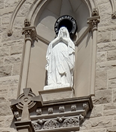Typology: Difference between revisions
→Typology as a tool for understanding the History of Salvation
No edit summary |
|||
| Line 1: | Line 1: | ||
'''Typology''' is the study of "types" or pre-figurements of Christ and other Scriptural persons or things and events that point to the fulfillment of the Old Covenant by Jesus Christ. | '''Typology''' is the study of "types" or pre-figurements of Christ and other Scriptural persons or things and events that point to the fulfillment of the Old Covenant by Jesus Christ. Jesus clarified, | ||
“Do not think that I have come to abolish the law or the prophets. I have come not to abolish but to fulfill.” <small>([https://bible.usccb.org/bible/matthew/5?17 Mt 5:17-19])</small> | |||
And as St. Augustine said (paraphrase),<blockquote>''The New is hidden in the Old, and the Old is revealed by the New.'' </blockquote>"Types" are the clues God gave the Old Testament prophets and inspired writers to point towards Christ. | |||
----''<nowiki>**</nowiki> page under construction **'' | |||
----See also [[Salvation History]] | |||
“Do not think that I have come to abolish the law or the prophets. I have come not to abolish but to fulfill.” | |||
== Scripture on Typology == | == Scripture on Typology == | ||
| Line 25: | Line 24: | ||
** which helps us to understand "[[Salvation History]]," or "God's Plan for Salvation | ** which helps us to understand "[[Salvation History]]," or "God's Plan for Salvation | ||
** by which Christ redeems mankind from the Fall of Adam and Eve. | ** by which Christ redeems mankind from the Fall of Adam and Eve. | ||
God reveals ("revelation") himself to us through Salvation history. He does not give it to us all at once! We're not ready for it -- and, that would be in violation of our own free will, as well as to be too much for us to handle. So he deals with us on our terms, not his, giving us bits and pieces and nudging us along towards understanding. | |||
== Revelation & typology in the "Road to Emmaus" == | |||
Two disciples who on Easter Sunday left Jerusalem for the village, "Emmaus," encountered a man along the way who explained to them all the things they did not understand about Christ. From [https://bible.usccb.org/bible/luke/24?13 Luke 24:13-35], "The Appearance on the Road to Emmaus":<blockquote>And it happened that while they were conversing and debating, Jesus himself drew near and walked with them, but their eyes were prevented from recognizing him. He asked them, “What are you discussing as you walk along?” They stopped, looking downcast. | |||
One of them, named Cleopas, said to him in reply, “Are you the only visitor to Jerusalem who does not know of the things that have taken place there in these days?” | |||
And he replied to them, “What sort of things?” They said to him, “The things that happened to Jesus the Nazarene, who was a prophet mighty in deed and word before God and all the people, how our chief priests and rulers both handed him over to a sentence of death and crucified him. But we were hoping that he would be the one to redeem Israel; and besides all this, it is now the third day since this took place. | |||
Some women from our group, however, have astounded us: they were at the tomb early in the morning and did not find his body; they came back and reported that they had indeed seen a vision of angels who announced that he was alive. Then some of those with us went to the tomb and found things just as the women had described, but him they did not see.” | |||
'''And he said to them, “Oh, how foolish you are! How slow of heart to believe all that the prophets spoke! Was it not necessary that the Messiah should suffer these things and enter into his glory?”''' | |||
'''Then beginning with Moses and all the prophets, he interpreted to them what referred to him in all the scriptures.''' </blockquote>First of all, not only did these two disciples know and live with Jesus, they got a first-class theological lesson from the resurrected Lord himself! | |||
We don't have the details of the lesson, but we do know it's focus:<blockquote>'''Then beginning with Moses and all the prophets, he interpreted to them what referred to him in all the scriptures.''' </blockquote>Jesus most likely began with Moses' prophesy in [https://bible.usccb.org/bible/deuteronomy/18?15 Deuteronomy 18:15],<blockquote>A prophet like me will the L<small>ORD</small>, your God, raise up for you from among your own kindred; that is the one to whom you shall listen.</blockquote>and then walked them through the various other prophets who proclaimed his coming, suffering and resurrection, including [https://bible.usccb.org/bible/psalms/22 Psalm 22], which he referenced from the Cross,<blockquote>My God, my God, why have you abandoned me?</blockquote>and ending with<blockquote>The generation to come will be told of the Lord, | |||
that they may proclaim to a people yet unborn | |||
the deliverance you have brought. <small>([https://bible.usccb.org/bible/psalms/22:32 Dt 22:32])</small></blockquote> | |||
== Typological clues == | |||
When reading the Bible, we will encounter various signals of Christ and the Gospel: | |||
{| class="wikitable" | |||
|+Types | |||
!Object | |||
!Meaning | |||
|- | |||
|water | |||
| rowspan="2" |baptism | |||
|- | |||
|river | |||
|- | |||
|wood | |||
| rowspan="2" |the Cross | |||
|- | |||
|tree | |||
|- | |||
|blood | |||
|Christ on the Cross | |||
|- | |||
|bread | |||
|Christ & the Eucharist | |||
|- | |||
|Fire | |||
| rowspan="3" |Holy Spirit | |||
|- | |||
|Dove | |||
|- | |||
|Cloud | |||
|} | |||
== Mary and the Ark == | == Mary and the Ark == | ||
